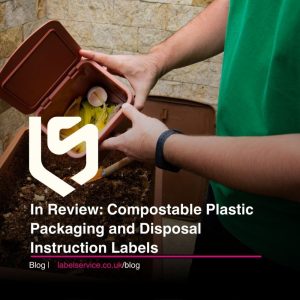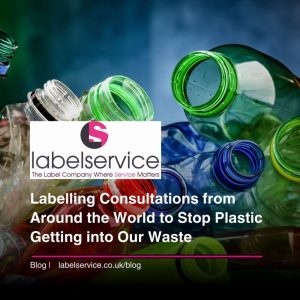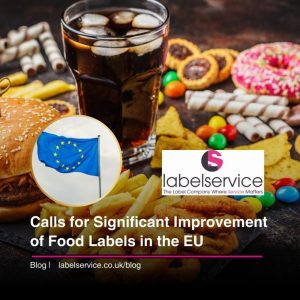Food labelling plays a critical role in helping consumers make informed decisions about what they eat. Labels are designed to provide clarity on ingredients, allergens, expiration dates, nutritional content, and even the ethical and environmental impact of products. However, an audit report by the European Court of Auditors (ECA) has revealed significant gaps in food labelling across Europe, with consumers often encountering confusing or misleading information.
Food labels are essential tools for consumers, offering critical information such as ingredient transparency which gives consumers detailed lists of ingredients to help them avoid allergens, additives, or unwanted components, nutritional insights so that labels provide calorie counts, macronutrient breakdowns, and other data for health-conscious buyers.
Shelf Life information is also important. Use-by and best-before dates guide safe consumption and help reduce waste, as is sustainability and ethics certifications like Fairtrade, organic labels, or eco-friendly logos inform consumers about a product’s environmental and ethical impact. However, the increasing complexity and inconsistency of food labels in Europe complicate their role. Instead of empowering consumers, they often leave them overwhelmed or misled.
The audit highlights issues with allergen information, expiration dates, and the proliferation of claims, logos, and slogans on food packaging. These challenges undermine consumer trust, affect public health, and compromise efforts to promote sustainability and informed purchasing. “Instead of bringing clarity, food labels too often create confusion; there are hundreds of different schemes, logos, and claims that people need to decipher,” said Keit Pentus-Rosimannus, the European Court of Auditors member responsible for the audit. The audit covered labels between 2011 and 2023. Auditors met with the Directorate-General for Health and Food Safety and the Directorate-General for Agriculture and Rural Development and interviewed authorities in Belgium, Italy, and Lithuania.
Allergen and shelf-life data challenges
Regulations require allergens to be emphasised in the ingredient list. However, people with food allergies may be faced with overly cautious labelling and vague statements such as “may contain.” A lack of harmonised rules at the EU level restricts their choice. Companies may apply the “may contain” wording to play it safe, and the use of this statement is not always based on risk assessments quantifying the presence of allergens. Implementing acts on precautionary allergen labelling has not yet been adopted by the EU Commission.
Confusion is made worse by the increasing number of voluntary labels, logos and claims used to attract consumers. These include “clean” labels about the absence of certain elements such as (e.g., “antibiotic-free” and uncertified qualities such as “fresh” and “natural.”
The EU allocated only about €5.5 million ($5.77 million) to food labelling awareness campaigns from 2021 to 2025, and consumer campaigns by member states are sporadic. For instance, although mandatory, date marking is poorly understood, with people confused by the meaning of “use by” and “best before.”
Companies can also take advantage of weaknesses in checks and penalties. For example, websites outside the EU are almost impossible to control for online food sales. The EU auditors concluded that fines are not always dissuasive, effective, or proportionate regarding infringements. Since the COVID-19 pandemic, all three member states visited have observed a rise in the sale of food products via e-commerce and an increased number of complaints about online stores. Information on such products can be misleading, and their consumption may even be unsafe.
Key Findings from the Audit Report
The ECA’s audit report uncovers several major issues related to food labelling across Europe:
1. Misleading Allergen Information
Accurate allergen labelling is crucial for individuals with food allergies, as even trace amounts of allergens can cause severe reactions. The report found:
Inconsistent Terminology: Variability in how allergens are described (e.g., scientific names versus common terms) creates confusion.
Precautionary Labels: Phrases like “may contain” or “produced in a facility that handles” are overused and lack standardisation, leaving consumers uncertain about the actual risk.
Unreadable Formats: Allergen information is often buried in fine print or poorly highlighted, making it difficult for consumers to identify allergens at a glance.
2. Confusion Over Expiration Dates
Expiration dates are a critical part of food safety and waste management, but the audit revealed widespread confusion:
Misinterpretation of Labels: Many consumers struggle to differentiate between use-by dates (indicating safety) and best-before dates (indicating quality).
Wastage Concerns: Misunderstanding these dates leads to unnecessary food waste, with consumers discarding food that is still safe to eat.
Inconsistent Presentation: Variations in date format and placement on packaging add to the confusion.
3. Proliferation of Claims, Logos, and Slogans
European food products are adorned with a growing number of claims such as natural, sustainable, low-fat, and high-protein. While these are intended to guide consumers, the report found they often create more confusion:
Lack of Regulation: Many claims are not standardised or verified, making it hard for consumers to distinguish between genuine and misleading information.
Overwhelming Choices: The sheer number of logos and labels on packaging makes it difficult to identify meaningful certifications.
Marketing vs. Clarity: Some claims prioritise marketing appeal over accurate communication, leading to misinformed choices.
4. Inconsistencies in Sustainability Claims
Eco-conscious consumers face a maze of terms and symbols that are often poorly defined or unregulated:
Undefined Terminology: Words like eco-friendly or sustainably sourced are frequently used without clear criteria or certification.
Logo Proliferation: A wide variety of sustainability logos and symbols make it hard to distinguish credible certifications from marketing gimmicks.
Carbon Footprint Labels: Some products display carbon emissions data without standardisation, leaving consumers unsure of its significance.
Impact on European Consumers: The issues highlighted in the audit report have far-reaching implications for consumers across Europe.
5. Erosion of Trust
Confusing and misleading labels undermine consumer trust in food brands and regulatory bodies. When shoppers feel deceived or overwhelmed, their confidence in the food system diminishes, affecting their willingness to engage with ethical or health-driven choices.
6. Public Health Risks
Ambiguous allergen information and mislabelled expiration dates pose significant risks to public health. Consumers with allergies may inadvertently consume unsafe foods, while confusion over use-by dates can lead to foodborne illnesses.
7. Increased Food Waste
Misunderstandings around expiration dates contribute to Europe’s food waste problem. The European Commission estimates that around 10% of the EU’s food waste is linked to date labelling confusion.
8. Barriers to Sustainable Choices
Sustainability claims are often poorly communicated, leaving eco-conscious consumers unsure of how to make environmentally responsible decisions. This confusion slows progress toward reducing the environmental impact of food consumption.
Addressing the Problem: Recommendations for Change
To address these challenges, the ECA report calls for targeted actions from regulators, industry stakeholders, and consumer advocacy groups.
-
Standardising Food Labels
- The EU should work towards greater standardisation of food labels to ensure consistency and clarity across all member states. This includes:
- Harmonising allergen terminology and presentation.
- Introducing standardised formats for expiration dates.
- Regulating claims and logos to ensure they meet clear criteria.
-
Improving Allergen Labeling
Allergen information should be prominently displayed and easy to understand. Strategies include:
- Highlighting allergens in bold or contrasting colours in ingredient lists.
- Providing consistent language for common allergens across all products.
-
Educating Consumers
- Public education campaigns can help consumers better understand food labels, particularly around expiration dates and nutritional content. This includes:
- Clarifying the difference between use-by and best-before dates.
- Promoting awareness of credible certifications and sustainability claims.
-
Strengthening Regulation of Claims and Certifications
The EU should introduce stricter regulations for food claims to prevent misleading or unverified statements. All sustainability and ethical certifications should undergo rigorous, standardised verification processes.
-
Leveraging Technology
Digital tools, such as QR codes, can provide additional information about products without cluttering packaging. Scanning a QR code could give consumers access to detailed ingredient descriptions, allergen information, and sustainability data.
The Role of Stakeholders in Driving Change
Governments and Regulators
National governments and EU regulatory bodies play a pivotal role in enforcing standards and ensuring that food labelling supports consumer needs. Increased oversight and collaboration with industry players are essential for meaningful reform.
Food Industry
Manufacturers and retailers must prioritise transparency and accuracy in labelling. Investing in clear communication and verifiable claims can enhance consumer trust and brand reputation.
Consumers
Educated consumers can advocate for better labelling practices by supporting brands that prioritise transparency and holding others accountable for misleading information.
Food labelling in Europe is at a crossroads. While labels are intended to inform and empower consumers, the findings of the ECA audit report reveal significant shortcomings in clarity, consistency, and accuracy. Ambiguous allergen information, confusing expiration dates, and the overwhelming proliferation of claims and logos undermine the effectiveness of food labels, with serious consequences for public health, consumer trust, and sustainability efforts.
Addressing these issues requires a coordinated effort between regulators, the food industry, and consumers. By standardising labels, improving allergen and sustainability information, and educating the public, Europe can create a food labelling system that truly serves its purpose—empowering consumers to make informed, confident choices about what they eat.
Auditors found that control systems in member states are sometimes complex and often involve multiple authorities, which may lead to weaknesses in monitoring, reporting, and sanctions. The EU Commission makes some information notified by member states available to the public via the Rapid Alert System for Food and Feed (RASFF) portal but not details that would allow a product to be identified, such as its name or involved companies. For example, a consumer could not find the product name on the portal during a recall. Instead, this information might be available in shops or through national authorities’ information channels.
“This makes it hard for consumers to use the portal to find out about issues relating to food safety and change their purchasing habits accordingly,” said auditors. Auditors recommended that when updating RASFF, the EU Commission should improve data quality and increase information sharing on food labelling issues with the public.
“What’s worst about the ECA report: Rather than a lack of competence, it underlines the lack of political will in the EU’s institutions to defend the rights of 450 million EU consumers instead of the interests of a powerful industry. Food labels may often be small in size. Still, they are of huge importance: They shape the eating habits of millions of people and therefore have a massive impact on the health of European consumers,” said Suzy Sumner, head of the Brussels office for Foodwatch International.

















